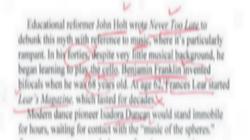With ever-rising skepticism among consumers and business buyers, promoters have a steep mountain to climb when writing marketing copy. In that challenging selling environment, however, it's still very possible to earn attention and sell. The key is understanding what readers need to make up their minds to act.
Be direct, and remember to support your argument with credibility-boosting evidence and vivid imagery. Use these seven tips to spin a spell with words.
1. Become more believable by including one or two facts that argue for the opposite conclusion. When researchers asked people to rate the truthfulness of an ad that claimed superiority in all respects to another that claimed superiority in all except two respects, they rated the latter ad as more truthful and persuasive.
2. Tone down claims that, while true, seem hard to believe. If a particular investment appreciated 500% in just six months, without any apparent reason, seasoned readers may suspect a scam. Saying it more than doubled in value may be both true and more believable.
3. Earn credibility with testimonials, endorsements from industry leaders, uncensored user opinions and media coverage. With a new company, new product or new service, what's often missing, says George Silverman, author of The Secrets of Word-of-Mouth Marketing, is confirmation that claims made are valid, as well as verification that results apply to a particular situation. Third-party opinions help quiet the doubts of buyers and boost the trust necessary for a purchase.
4. Go head-to-head against the objections lurking in some readers' minds. Social psychologists at the University of Toledo tested the tactic of admitting a weakness of their case, rather than let it be brought up by the opposition, in both a civil and a criminal simulated trial. In both trials, doing this affected the verdict, influencing jurors to set aside the relevance of the negative information.
5. Turn negative points of your product imaginatively into virtues. For instance, ads for Jitterbug, a cell phone designed especially for seniors, boast that the device can't surf the Net, doesn't let you play games and won't tell you the weather. It simply functions as a phone, and for that population, those negatives become plusses.
6. Explicitly draw conclusions for readers instead of expecting them to make connections that feel obvious to you. It may seem obvious that the impending closure of your community hospital means that someone with a medical emergency in your neighborhood is more likely to die on the way to a hospital farther away, but people often don't realize such implications until you point them out in so many words.
7. When using numbers to make a point, always state what they show, with a story or caption for a chart. In one experiment, more than twice as many readers absorbed nutritional information when researchers presented it in a story than in a chart. Significantly more people exposed to the storytelling version remembered the point afterwards, too.
With added sensitivity to the persuasive principles above, your copy does a much more powerful job of turning words into profit.
Copyright 2015 Marcia
Yudkin. All rights reserved.
Read
about my mentorship program for copywriters /
marketing consultants.






